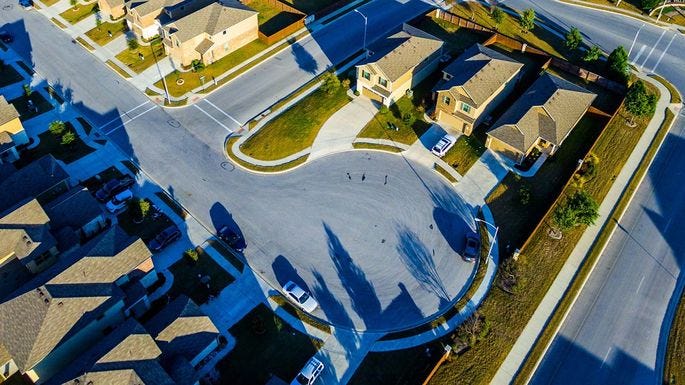 |
| Image by Bernardo Ferreria from Pixabay |
Cities are sexy. They’re all adventure and possibilities. Risking it all for the chance to hit it big. They have a daring, “If I can make it there, I’ll make it anywhere!” vibe. They are the siren in stilettos or the beefcake on the cover of the raunchy novel — they get your heart going, but they’re not the one you settle down with and marry.
Is it any surprise that the statistics show Millennials moving away from their hipster city digs toward suburbs as they reach their 30’s and have kids? Turns out that the “right one” is not only safe, they’re a cheap date too — housing prices in the suburbs can be 1/3 of the cost of their boujee counterparts. Still, it’s not just the price tag that drives the migration.
It’s panic.
The panic of watching the toddler who has captured your heart dart out into a busy street. It’s the panic of trying to get somewhere safely with a little one in tow. It’s images of Bruce Wayne and his parents in that dark alley, pearls strewn across the pavement. Cities are not safe. That’s all well and good when all you have to look out for is yourself. It’s unacceptable when you are watching out for people you can’t bear to lose. A thousand discomforts can be managed. A single real danger is a deal-breaker. Maybe that explains why my pediatrician swore that “nesting” for dads means buying a new house. Even Iron-Man chooses a cabin in the woods to raise a daughter instead of a high-rise in the city.
The good news for urban designers is two-fold. Migrants to suburbia still want urban connectivity and features. They care about the planet, they just aren’t willing to endanger their loved ones — and they shouldn’t. Multi-generational sustainability is useless if your kids can’t survive their childhood. Second, you can have it both ways if you’re careful. Urban hasn’t always meant big cities with extensive transit systems. Most of the early suburbs would have been considered very urban by today’s standards — walkable, bikeable, and close to everything but the family’s employment. With digital work connectivity, distance to work may become less important anyway. Small scale land use mix and local scale retail/services are key to surviving the retail apocalypse as well as making active transportation feasible.
In the meantime, urban designers could take a lesson or three from observing suburban settings with an eye for what they have done right — the features that make them safe and convenient for the most vulnerable users in the society. It’s nice to live on a cul-de-sac or loop street. It’s even nicer when that dead-end street becomes a live-end street because it has pathways connecting through the dead-end.

Buffer the connections with landscaping, fences, and lighting. Make sure bikes and people can get wherever they want but cars can’t. The resolution of the network for each mode needs to fit the scale of the mode: connections at 1/8 mile or less for ped/bike, 1/4 mile for scooters, e-bikes, or golf-carts; 1/2 mile for cars. Drive-throughs are not the bane of our existence — for a mom with a sleeping baby, they’re a God-send. Let’s figure out how to do both. Those babies don’t stay little forever.
I am fascinated by the transformation the Netherlands made from car-centric patterns to bike and walk modes that are safe for children as young as three or four. The choice was intentional. Rather than trying to fit bikes into a car-oriented culture, training bikers to think and act like a car, they chose children as their design priority. When children can bike, everyone can bike — and they do. The transformation was driven by moms that were horrified at children being killed in the streets. We now have an entirely new generation of millennial moms that we have trained to love urban environments, including walking and biking as a normal part of life. When they figure out that it’s a lot harder to keep the weight off when they’re driving everywhere, they’re going to want to see change, but not without serious safety precautions.
Rather than suburban, is it possible to create small-urban? Why not?
What strategies can you think of that can bridge the gap from suburban to small-urban?

No comments:
Post a Comment